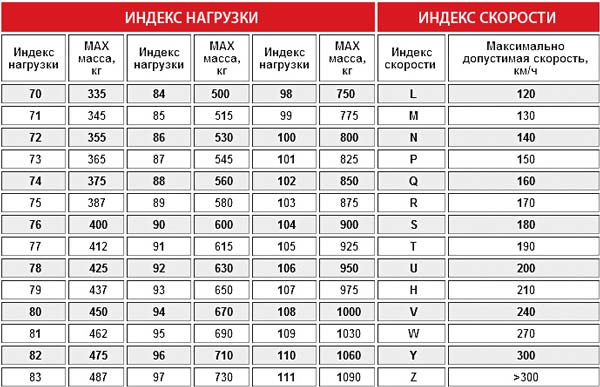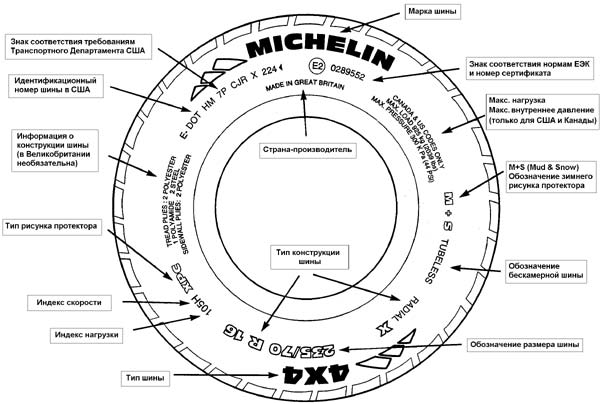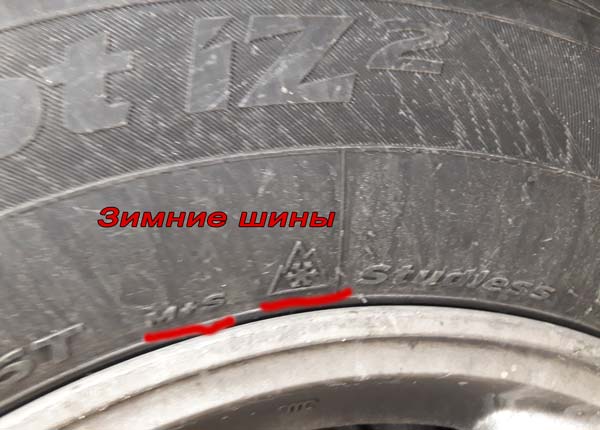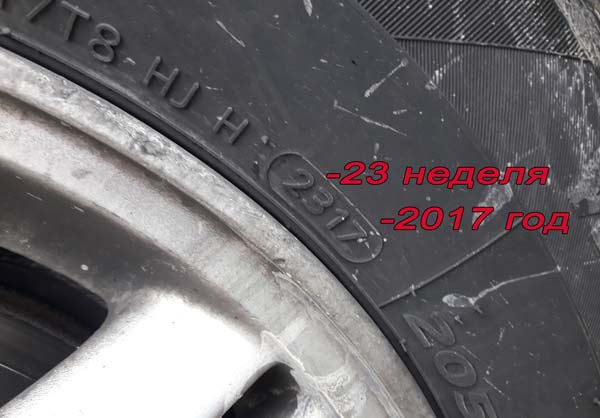Each tire has a number of parameters that you should pay attention to when buying. All indicators are of great importance, because from them you can learn about the age of rubber, its characteristics. This will help you choose the most suitable shoe for your car, based on the characteristics of operation.
This article is devoted to the load index of passenger car tires. We will look at the decoding of the parameters, what these numbers mean, where they are printed and how to choose a tire for your car.

All tire manufacturers need to specify a number of parameters on their products. These include the dimension of the wheel itself. Depending on the type of marking, these indicators can be indicated in millimeters or inches.
Look at the sidewall of the tire. If there are parameters, for example, 225*55*R17, then this indicates that the kit was produced for consumers from European countries. Tire manufacturers for Europe apply a certain series of numbers indicating the following sizes:
- the first number denotes the distance from one side to the other, i.e. tread width - 225 mm;
- the second is the ratio of tire profile to width or tread height. It is important to understand here that this indicator is variable and depends on the width of the tire. That is, tires 225 * 55 * R17 and 185 * 55 * R17 differ in their size;
- the third - stands for inner diameter - 17 inches;
- the letter r indicates that we have a tire with a radial weave cord. There are also diagonal tires, where instead of a letter there is a “\” icon.
American companies have developed their own labeling of their products, where the tire size is indicated in inches. The overseas type of designation has the format, for example, 33*11*R17, and such an index is interpreted as follows:
- The first number indicates the outer diameter of the wheel - 33 inches. This indicator is static and convenient to use, as it does not depend on the width, as in the European format;
- the second digit is the tread width - 11 inches;
- the third - carries information about the inner diameter of 17 inches. This method is more convenient, because all indicators are indicated separately and do not depend on each other. If you get used to the calculation in inches, then it becomes easier to select the right kit.

Along with the dimension indicators, other mandatory parameters are applied on the sidewall of the tires - load and speed index, manufacturer's brand, rubber model, production date and maximum allowable pressure.
The presence of colored marks indicates tips when mounting the wheels. The yellow triangle tells where is the lightest spot in the sidewall of the tubed tire, which should be aligned with the special mark on the rim. The red triangle indicates the hardest spot on the tubeless tire and is also aligned with the corresponding mark.
Additionally, on car tires you can see different markings and pictograms indicating seasonality (4 season, all season), the direction of rotation of the wheels (rotation + arrow), marking the outer or inner side (outside or inside) for rubber with an asymmetric tread. All these indicators, including the load index, will help you calculate and choose the right shoes for the car, and will also be able to guarantee a safe ride.
Load designation

One of the most important parameters is the tire load index. This indicator indicates the maximum weight that the tire must withstand. The designation of the load index marking is expressed in a numerical value and is located near the dimension of the wheel.
Therefore, when choosing rubber, it is worth looking at this indicator. For a competent calculation of the load index value, the total mass of the car with luggage and passengers in the cabin should be taken into account.
Separately, you need to remember about some of the nuances. For example, a wheel may be suitable for carrying capacity, but due to uneven distribution of luggage or passengers, the load may exceed the allowable limits. Therefore, it is worth playing it safe and taking a kit with a higher rate. This will provide an additional margin of safety and will allow you to be confident on the road.
Sometimes the tire load index has a double meaning, which is written with a hyphen. This means that the wheels are homologated for cars with twin tires. The first number on the tires indicates the load indexes in a single state, the second - in a paired state. For example, the numbers 106 * 102 mean that if you use the tire in paired form, then the maximum load will be 850 kg, and with a single wheel installation, it can withstand 950 kg. 
You can often find additional designations next to the tire load index in the form of the letters EL, which stands for Extra Load or the words Reinforced. Such tires are distinguished by a reinforced structure, which implies additional layers of cord and breaker. The labeling of these kits is somewhat different. It is worth adding 3 more units to the indicated tire load index.
It should also be remembered that the calculation of the vehicle load index coefficient is carried out on the basis of the maximum pressure in the wheels. Information about what pressure should be in the tires is contained on the side of the product, closer to the inner circumference. The parameter is measured in atmospheres or kilopascals.
Tire load index table
| Table | |||||
|---|---|---|---|---|---|
| Index | |||||
| 85 | 515 | 97 | 730 | 109 | 1030 |
| 86 | 530 | 98 | 750 | 110 | 1060 |
| 87 | 545 | 99 | 775 | 111 | 1090 |
| 88 | 560 | 100 | 800 | 112 | 1120 |
| 89 | 580 | 101 | 825 | 113 | 1150 |
| 90 | 600 | 102 | 850 | 114 | 1180 |
| 91 | 615 | 103 | 875 | 115 | 1215 |
| 92 | 630 | 104 | 900 | 116 | 1250 |
| 93 | 650 | 105 | 925 | 117 | 1285 |
| 94 | 670 | 106 | 950 | 118 | 1320 |
| 95 | 690 | 107 | 975 | 119 | 1360 |
| 96 | 710 | 108 | 1000 | 120 | 1400 |

Selection of high quality and safe tires
Another important indicator that you should look at when choosing rubber, in addition to the tire load index, is the speed index. It is indicated by a Latin letter and indicates the maximum permissible speed of the selected kit. The speed and load indicators are indicated together and influence each other. The greater the load capacity, the greater the margin of safety.
The minimum value acceptable for modern cars is N. This implies that the maximum speed at which you can drive is 140 km / h. Driving the car at a given speed for several hours will not damage the tread structure. Exceeding this speed will result in severe tire wear and possible wheel damage.
Every 10 km / h, the kit receives the next letter, closer to the end of the Latin alphabet. If you want to drive at high speeds on good roads, then the tires should have an H, V, W or Y index.
For winter tires, this indicator is not so relevant. The operating conditions of the car do not allow to reach the maximum speed. Therefore, it is worthwhile to understand that it is necessary to build on the class of car and choose a winter kit based on the tread pattern and the characteristics of operation and weather conditions.
The same is true if you are thinking about which index for an SUV is best. Here it is preferable to abandon high-speed tires in favor of rubber with a high load index. The full classification of the tire speed index is shown below.
| Tire table | |||||||||||
|---|---|---|---|---|---|---|---|---|---|---|---|
| Litera | N | P | Q | R | S | T | U | H | V | W | Y |
| Speed | 140 | 150 | 160 | 170 | 180 | 190 | 200 | 210 | 240 | 270 | 300 |
In conclusion, it is worth saying that new rubber clings to the surface better than old, worn tires. The load index of such products can also become smaller with age. Therefore, as it is better to fill in fresh fluids in a timely manner for the full operation of all systems, it is preferable to change tires every three years.







